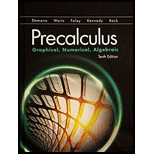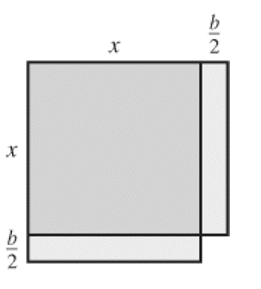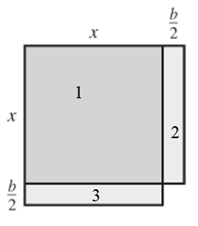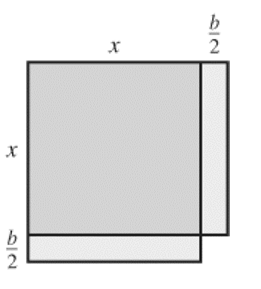
a)
To find: The area of the given figure.
The required area is
Given Information:
The square shown in figure 1.

Figure 1
Concept Used:
The area of square is
Calculation:
Consider the 3 rectangles as shown in the figure 2.

Figure 2
The area of square 1 is
Thus, the area of given figure is,
Therefore, the required area is
b)
To find: What area must be added to complete the large square
The the area that must be added is
Given Information:
The square shown in figure 1.

Concept Used:
The area of square is
Calculation:
Consider the 3 rectangles as shown in the figure 2.
In order to complete the square, a square of side
The area of square of side
Therefore, the area that must be added is
c)
To explain: How the algebraic formula for completing the square models the completing of the square in part (b).
Given Information:
The square shown in figure 1.
Explanation:
The area that must be added to complete the square is
Now, let the area of the given figure be
Use the completing the squats method as follows.
Add square of half times the coefficient of
Thus, it follows that, in order to complete the square,
Chapter 1 Solutions
EBK PRECALCULUS:GRAPHICAL,...-NASTA ED.
 Calculus: Early TranscendentalsCalculusISBN:9781285741550Author:James StewartPublisher:Cengage Learning
Calculus: Early TranscendentalsCalculusISBN:9781285741550Author:James StewartPublisher:Cengage Learning Thomas' Calculus (14th Edition)CalculusISBN:9780134438986Author:Joel R. Hass, Christopher E. Heil, Maurice D. WeirPublisher:PEARSON
Thomas' Calculus (14th Edition)CalculusISBN:9780134438986Author:Joel R. Hass, Christopher E. Heil, Maurice D. WeirPublisher:PEARSON Calculus: Early Transcendentals (3rd Edition)CalculusISBN:9780134763644Author:William L. Briggs, Lyle Cochran, Bernard Gillett, Eric SchulzPublisher:PEARSON
Calculus: Early Transcendentals (3rd Edition)CalculusISBN:9780134763644Author:William L. Briggs, Lyle Cochran, Bernard Gillett, Eric SchulzPublisher:PEARSON Calculus: Early TranscendentalsCalculusISBN:9781319050740Author:Jon Rogawski, Colin Adams, Robert FranzosaPublisher:W. H. Freeman
Calculus: Early TranscendentalsCalculusISBN:9781319050740Author:Jon Rogawski, Colin Adams, Robert FranzosaPublisher:W. H. Freeman
 Calculus: Early Transcendental FunctionsCalculusISBN:9781337552516Author:Ron Larson, Bruce H. EdwardsPublisher:Cengage Learning
Calculus: Early Transcendental FunctionsCalculusISBN:9781337552516Author:Ron Larson, Bruce H. EdwardsPublisher:Cengage Learning





